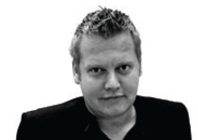As a technology journalist, there’s the constant anticipation of what product or capability is coming next. Incremental, evolutionary improvements are all well and good but what really excites me is revolutions, writes Martyn Day
As a kid I read the 2000AD comic. I have to say I was pretty disappointed when we got to the year 2000 and it didn’t feel too different from 1982. There was a distinct lack of cyborgs or robots, personal rocket packs, and brain implants to make us all Einsteins. A post apocalyptical nuclear war was nowhere to be seen and we couldn’t even muster up a promised Y2K meltdown. Even the Terminator’s battle against humanity would have been over quickly if he was running Windows Vista. So much for scientists and the predictions of Sci-fi writers, we had to leave it to our bankers to have a stab at making the apocalypse.
In my real life role as a journalist I get to talk to Chief Technology Officers (CTOs) of lots of CAD companies and get occasional sneak peeks into the future, feeding my wonder lust for what’s coming next… and yes I was the kind of kid that used to grope the Christmas presents to try and deduce their contents. A recent interview with Autodesk’s CEO, Jeff Kowalski, turned particularly interesting when he said, ‘Why do people get given a PC to do their jobs, I never asked to be given a computer when i got this job!’ Kowalski hadn’t gone insane, we were discussing the limitations of being tied into pre-conceived notions as to what computers can do – of what they have come to represent. With all this talk of cloud computing and mass-processing happening off-site, will we need raw power on the desktop in the future? Will we need computers or just a window into the cloud?
I was pretty disappointed when we got to the year 2000 and it didn’t feel too different from 1982
The whole cloud concept is the current ultimate in the movement to on-demand computing. This would impact what you need at our end, with dumb terminals running browsers being enough to feed instructions and data to a super-computer centre somewhere in a desert. Companies like HP and Dell have already delivered workstation rack technology that allows the physical workstation to reside far away from the front end screen. Users just have a dumb terminal that only ever sends and receives the graphic display elements across the net. There is no local hard drive and memory.
While the initial benefit is central location of processing and dynamic allocation of processing power, in this globalised world, this is already being considered as a way to keep the data stored safely and centrally while groups of workers can access a project 24/7, all from the same machine. You could buy just one HP Blade workstation to cater for three engineers covering significant time zone changes. Cloud computing won’t just change the way you pay for or use processing power but has the potential to radically change local computing fire-power. The future looks like it’s terminals for all.
In a desktop or in a cloud data centre, while the processor clock speed race seems to have slowed, the concentration of development effort has gone into adding multiple core to get speed from the parallelism of tasks. Kowalski stated that while we will soon have eight and sixteen cores in one chip, the CAD software industry hasn’t done a great job of making much use beyond two of these cores yet. Kowalski envisions computers with hundreds of cores which will all eventually be utilised by software applications allowing new capabilities and experiences. When you work in your future CAD application the software will have the capacity and knowledge to simultaneously pre-process your next likely requests, instantly producing renderings and analysis results for design changes – or giving constant feedback on the sustainability of the design. It seems speed of processor will no longer be the limitation it used to be back in the days of the Intel 386. Instead, speed will be measured by how good the computer is at guessing what you want to do next.

Most kids dream of playing football for England. Martyn was different. He longed to live in a post acocalyptic world where everyone owned personal rocket packs
Mixing Kowalski’s views with other industry visionaries, like Bernard Charlès, CEO of Dassault Systèmes (DS), I get the impression that the industry is focussing on knowledge, its capture and reuse. Charlès talks of capturing design DNA and remixing designs for effective reuse of knowledge. DS has been working with Toyota to produce definitions of cars, so 3D models of saloons can be morphed into fully detailed estate cars or off-road vehicles. It’s all about capturing knowledge and defining rules and then anticipating how it will be reused. It’s at this point that computer science meets the psychology of design, the prediction of human behaviour and intelligently rationlising designs to provide useful building blocks to speed the process of iterative product creation. These are big ambitious projects but very achievable.
For now, I will have to make do with the innovations within the design industry to satiate my need for scientific progress. Obviously, that is until the development of the next generation of CAD tools will ultimately lead to the development of Fusion power, space travel, the flux capacitor and the teleport. To infinity and beyond!
{encode=”martyn@x3dmedia.com” title=”martyn@x3dmedia.com”}

Evolution is good. Revolution is better, says Martyn Day






